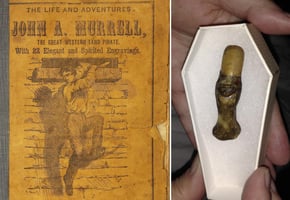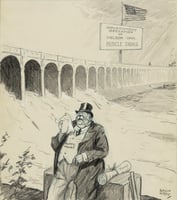The accounts of the “Great Western Land Pirate”, John A. Murrell are enough to fill many, many...
Beyond the "Happy Slave" Myth: The Uncomfortable Truth About Alabama Governor Patton and Sweetwater Plantation

Robert M. Patton, Alabama's governor from 1865 to 1867, is often portrayed as a complex figure, caught between the remnants of the Confederacy and the emerging era of Reconstruction. However, a darker aspect of his legacy remains undeniable: his ownership of enslaved people at Sweetwater Plantation in Florence, Alabama.
Robert M. Patton’s Slave Plantation
In 1860, the agricultural census revealed that Sweetwater Plantation, spanning 4,000 acres, was home to 118 enslaved individuals. Some sources like the Encyclopedia of Alabama state that the number of enslaved people on the plantation may have exceeded 300. The enslaved population at Sweetwater included individuals of all ages, from infants to the elderly.
The plantation itself was a lucrative enterprise, producing a variety of crops, including wheat, rye, corn, oats, cotton, wool, peas, beans, and potatoes. In 1860, Sweetwater's estimated cash value was $80,000, and it boasted a significant amount of livestock.
The labor of the enslaved people at Sweetwater was undoubtedly instrumental in the plantation's economic success. Their forced toil contributed to Patton's wealth and privilege, reinforcing the oppressive system of slavery that underpinned Southern society.
The "Happy Slave" Myth
Let's be clear: there's no such thing as a "happy slave." The idea that enslaved people were content with their lot, loyal to their enslavers, or somehow complicit in their own oppression is a dangerous myth. It minimizes the brutality and suffering they endured, erasing the human cost of slavery.
Patton wasn't some benevolent owner overseeing a harmonious plantation. He was part of a system built on violence, control, and the complete denial of basic human rights. The lives of 300 people were his property, their labor used to fuel his wealth and privilege.
While Patton may have later vetoed discriminatory Black Codes, his actions as governor were still steeped in white supremacy. He resisted Black enfranchisement, ensuring continued white dominance. And then there's the convict-lease system – a system that exploited prisoners, many of them likely formerly enslaved people, for cheap labor.
Understanding Sweetwater Plantation
Understanding the true story of Sweetwater Plantation, and the lives stolen there, is crucial. It forces us to confront the uncomfortable truths of our past. It reminds us that freedom wasn't some gift bestowed upon Black Americans, but something they fought tooth and nail to achieve.
Let's move beyond sanitized narratives and delve into the complexities of this period. Let's remember the 300 people at Sweetwater Plantation, not as cogs in a machine, but as individuals robbed of their freedom. Their stories deserve to be heard, their suffering acknowledged. Only then can we begin to understand the true legacy of figures like Governor Patton, and the fight for a more just future.


